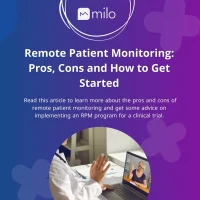Patient screening is the process that initiates the recruitment of patients for a clinical trial, and it is essential to determine the eligibility of potential participants. It uses inclusion and exclusion criteria to create an ideal target patient profile and ensure optimal recruitment.
In this article, we discuss the role participant screening plays in clinical research, what are the challenges faced by researchers and CROs, how to overcome these challenges with good planning, and how technology can be used to help this process. Save this article for future reference and share it with someone who might benefit from this knowledge.
Why Patient Screening is Important ?
Because it is not just about selecting people: it is a rigorous type of selection that must ensure that only participants that “match” the study’s objectives are enrolled. While this might seem simple when we describe it, it can actually be a complicated and challenging process.And why is it so important? First, it is a successful screening which will provide the study with the necessary number of participants. A clinical trial cannot be conducted with no trial participants. However, quantity is not everything. The “quality” of the participant’s pool matters as much as the numbers.
Quality, in this case, means how much the profile of the people who enrolled match the ideal participant of the trial. This potential subject is designed based on the study’s objectives, the type of drug or medical device being developed, who is the target population, among other characteristics.
Failures in the process of screening patients may lead to enrollment delays, which will delay the rest of the study consequently. Another impact of screening failure that shows the importance of this process is the possible increase in costs, due to the extension of the trial’s timelines.
Finally, it is also patient screening that allows researchers to start working towards what is one of the goals of many patients’ recruitment processes today: diversity. It is through good design and management of the screening process that accessibility can be enhanced, reaching a wider and more diverse population.
Therefore, there is no doubt that mastering this process should be the goal of every research group and CRO. However, we acknowledge that there are some challenges which might represent an obstacle to optimal patient recruitment. In the next section, we explore some of these hurdles, before giving some advice on how to overcome them.

Challenges in Patient Screening
Although some might think of it as an easy task, not very different from creating a regular advertising campaign, participant screening can be a complex and challenging process. These are some of the hurdles faced by researchers and CROs:
- Designing inclusion/exclusion criteria. Determining the right criteria to select patients can be a challenge, as too strict pre-requisites can make it harder to reach recruitment goals, and the opposite may have the enrollment of people who are not a good fit as a consequence
- People’s fears. It is natural that people have concerns about joining the trial of a medicine or medical device which is still under study. This becomes a challenge when researchers are not able to gain the patient’s trust and cannot to explain the benefits for them
- Overwhelming consent process and burdensome trials. It all starts with patient selection, but the trial will probably be already designed by the time the screening starts. It is harder to approach and select people for a trial that is likely to take too much of their time or be a financial burden for them
How to Plan a Successful Screening Process ?
In this section, we provide some tips on how to conduct a successful screening, ensuring good trial outcomes from the beginning. As we have seen, there is a number of factors that contribute to screening failure, from poor trial design to setting the wrong inclusion/exclusion criteria. Here are some recommendations for overcoming these challenges:
- Start by analyzing closely the trial’s target group. Consider whether the ideal participants would be more easily reached through social media or more traditional communication means. Also, knowing well who the people you are trying to enroll are ensures that you use the right language to communicate with them at the screening stage
- Be realistic. When defining inclusion/exclusion criteria, the intention to reach only the most ideal candidates may result in too strict conditions which, in fact, create a non-existing patient profile. The “ideal participant” is a hypothetical model that should be a guide to selection, not a set of rules that may hinder the screening process
- Divide the screening process into stages and choose three to four top characteristics that will be the criteria for the first stage. By starting with broader criteria and then moving to more specific standards, you avoid excluding right away participants that may have been a good fit, even if not perfect
Using Technology to Enhance Patient Screening
Among the things that can help avoid screening failures, digital technology is the most effective one. The participant screening benefits immensely from a digital-first approach. Here is how technology can improve patient selection:
- The use of digital pre-qualification tools may help broaden the geographical reach of a study. This way, researchers can select patients from underrepresented populations, and include them in clinical trials that are more representative and diverse
- Digital screening tools can capture and analyze vast amounts of patient data from various sources, including clinical records, genomic testing, and centralized screening and prognostic tools. Although human effort could potentially reach the same results, it would take a lot more time and the risk of errors is higher
- Digital screening can also reduce patient burden and make them more likely to collaborate with the success of the screening. Using remote capabilities to reach patients who live far away from the study site and using technology to align the study design to the patients’ unique needs are ways to reduce the burden on them and facilitate screening. Electronic consent is another digital technology which can help make trials more accessible and attractive.
Summary
- Patient screening is the process that initiates the recruitment of patients for a clinical trial
- It is a rigorous type of selection that must ensure that only participants that “match” the study’s objectives are enrolled
- may lead to enrollment delays, which will delay the rest of the study. Another impact of screening failure that shows the importance of this process is the possible increase in costs, due to the extension of the trial’s timelines.
- It is also patient screening that allows researchers to start working towards diversity
- It can be a complex and challenging process because of designing inclusion/exclusion criterias, people’s natural fears and overwhelming consent process and burdensome trials
- Some recommendations for overcoming these challenges are to start by analyzing closely the trial’s target group, be realistic about the target group, divide the screening process into stages and use technology







